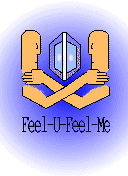



Copyright 2000 Stewart Dickson and Rebecka Dickson
Larry is back again in Steve's laboratory.
The computer-interfaced "pin-screens", Steve has made are
rectangular and generally flat, a little smaller than a briefcase.
They are mounted on tripod-like stands. Cables connect the pin-
screens to computers in the lab. Steve has guided
Larry to the screens. Larry is getting oriented.
Steve goes to the computer console and the demo begins.
Larry puts his hand against one of the screens and the other screen
moves to assume the convex shape of his hand imprint. The
screen is obviously made of metal but the metal gives when pressure
is put on it, the way thick mercury would, or metallic Jell-o. The
satiny surface looks like it is made of tiny metal beads, each the
thickness of a rounded sewing needle. The
cells can also emit light.
The region of the device which is reproducing the shape of Larry's
left hand is also assuming the color of his skin.
Larry places his hand on the other screen. Standing with his arms
spread apart , he is feeling the images of his opposite hands
simultaneously on opposite sides of him. He reacts physically to the
strange, disembodied sensation.
Steve begins to explain how he has constructed the device, "I am
mass-producing tiny processor/motor elements from Silicon, each the
size of a grain of sand, which can function together like a
programmable 'organic colony'. The structure is entirely self-
organizing. The only variables are the size of the base pad and the
number of elements installed on it.
"It's really remarkable. My printer turns out a sheet of ten-thousand
cells in about a minute. And the raw material is Silicon. It's
essentially sand. The pads you are touching have about a million
cells on them.
"The 'in-the-round' device is behind you. It has over ten million
cells."
Behind Larry is cubic form on a table -- much larger than the
screens, but it has the same surface quality.
Steve continues, "I think you'll find that the low-profile device is
better for reading text and 2-d graphics, like your Braille pad, but
for a greater range of depth, you need a bulkier device."
Steve prepares to demonstrate a 3-D computer "animation" --
projecting a 3-D scientific visualization into the "colony" device.
Larry turns, approaches it and feels the surface.
Steve warns, "OK, watch out now -- it's going to animate."
Larry pulls his hands back.
Steve continues, "It is sensitive enough to touch so that it will not
damage itself, but I'm not entirely sure that this prototype is
absolutely safe to touch while it is animating."
The device suddenly morphs from a cube into a 3-D plot of
the Riemann Zeta function. It is a fantastic, canyon-like smooth
mathematical terrain. The surface also changes color to display
a computer-generated topographic gradation in 3-D.
Steve gives the 'all-clear', "OK, it's stopped now."
Larry, feeling the new form, smiles, "Why... It's the primes!"
After Larry has explored the form thoroughly, Steve quits the
current program. He says, "I have made another demonstration
program you might find amusing." Steve starts another program.
Larry has not moved his hands away, but the device is suddenly
"aware" of the presence of his hands.
The surface begins to engulf Larry's left hand. As it makes contact,
color flows from his hand across the surface of the device -- the
color map looks like the tendrils of plasma in Steve's sculpture.
Swirls of electric blue-pink -- like Redferns description of visualized
human aura.
Steve, however, seems more involved with the technical aspects of
the machine and the demo at hand, and he doesn't seem to notice the
color changes. He tells Larry, "The device is digitizing your hand in
real-time by contact. The
cells are like combined nerve and muscle
cells of an electronic blob creature. They communicate optically
within the structure."
As one part of the structure is engulfing Larry's hand, a hand shape
begins to grow out of another part of the structure. The duplicate
hand moves with the movements of Larry's real hand.
Steve directs Larry, "There is a dynamic, 3-D projection of your hand
to your right."
Again, Larry explores his 'teleported' hand, in-the-round, this time.
Steve continues, "The
cells detect not only touch, but light, heat and
electrical impulses. I think it could work as a hi-res EKG or EEG if the
bio-medical people would try it out. Maybe you could help me chalk
up some data say, maybe next week?"
Larry says, "Oh, sorry, not next week. It looks as though I am going
to be traveling to a Techno-Art conference in San Francisco next
week."
"More of the stuff that was at your girlfriend's
Cafe?"
Steve asks.
"Yeah," Larry replies, "It's called the Inter-Symposium on Electronic
Art. It's not really my thing, but Theo wanted me to go and collect
documentation for her."
Steve is optimistic, "We could still do it remotely, they interface to
any PC."
Larry is not sure, "This is so new. Are you sure you could part with
it for a whole week?"
Steve replies, "I have ample resources to make several of these, I
really want to get going on this, I don't know when they are
going to okay me for MARS Project and I don't know how
much notice they'll give me before I go. I was so into the
laser sintering for so long and now with this," Steve holds up
another metal screen, "I feel like I want to go a whole new
direction."
"Well, sure," Larry says, taking the screen from Steve's hands.
"It feels about the size that would fit in my bag."
Steve is delighted, "Great, Thanks. Here, take two," he says.